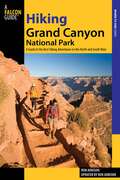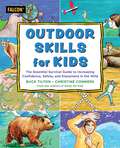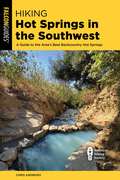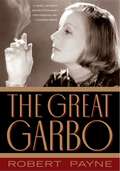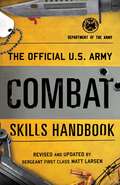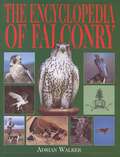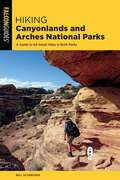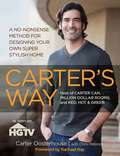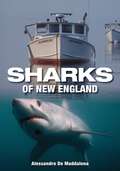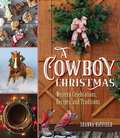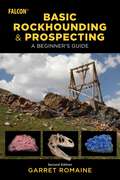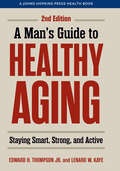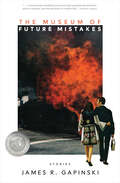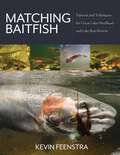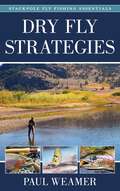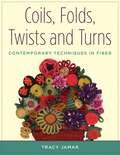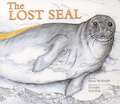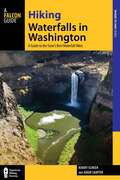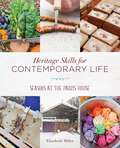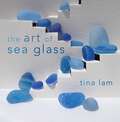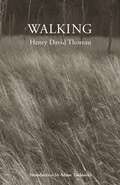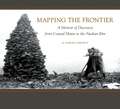- Table View
- List View
Hiking Grand Canyon National Park: A Guide to the Best Hiking Adventures on the North and South Rims (Regional Hiking Series)
by Ron AdkisonFully revised and updated, Hiking Grand Canyon National Park provides first-hand descriptions and detailed maps for all of the park's developed trails as well as tips on safety, hiking with children, access, and services. Includes fifteen hikes in the South Rim and thirteen hikes in the North Rim.
North End Italian Cookbook: The Bestselling Classic Featuring Even More Authentic Family Recipes
by Marguerite DiMino BuonopaneThink of Boston’s North End and you will envision a place filled with great food. Italian markets filled with strings of thick sausage, great wheels of cheese, bushels of seafood, slabs of dark chocolate, and mounds of fresh fruits and vegetables line the streets. For generations, the cooks of this Italian-American neighborhood have transformed these wonderful ingredients into memorable meals. For more than 30 years, Marguerite DiMino Buonopane, one of the North End’s most celebrated cooks, has shared her secrets to creating this culinary magic in your own kitchen. Now she gathers more than 275 of her own mouthwatering recipes peppered with savory color photos. The result is a full-color, deluxe edition of a treasured cookbook classic.
Rocky Mountain Vegetable Gardening Guide
by Cheryl Moore-Gough Robert GoughRocky Mountain Vegetable Gardening Guide is the definitive guide to vegetable gardening in the five states that comprise the Rocky Mountain region. Expert horticulturist, Cheryl Moore-Gough, addresses the unique growing conditions and challenges of this region from how to select, grow, and harvest a host of vegetables that will succeed to offering tips for extending the season.Rocky Mountain Vegetable Gardening Guide is the definitive guide to vegetable gardening in the five states that comprise the Rocky Mountain region. Professional horticulturist, Cheryl Moore-Gough, addresses the unique growing conditions and challenges of this region from how to select, grow, and harvest a host of vegetables that will succeed to offering tips for extending the season.
Outdoor Skills for Kids: The Essential Survival Guide to Increasing Confidence, Safety, and Enjoyment in the Wild (For Kids)
by Buck Tilton Christine ConnersBuck Tilton, co-founder of the Wilderness Medicine Institute and author of over 40 outdoor books, shares his decades of wilderness experience with young readers in Outdoor Skills for Kids. Partnering again with author and artist Christine Conners, this book offers over 100 important wilderness lessons including: What to do when you get lostHow to respond to wild animalsBasic first aidWays to stay positive in a survival situationOutdoor Skills for Kids is loaded with:Fun factsGamesSafety tipsInspiring true stories of kids who used these same skills successfully in survival situationsBuck and Christine are the creators of the highly successful Knots for Kids. This is the second in their series of outdoor skills books for educating young readers.
Hiking Hot Springs in the Southwest: A Guide to the Area's Best Backcountry Hot Springs
by Chris AndrewsWhether you're seeking a soak in naturally heated mineral water or out for a sightseeing adventure, this book guides you to the best sites for soaking in the beauty of the Southwest. Across Arizona, Nevada, Utah, Colorado, New Mexico and California, author Chris Andrews reveals his favorite "hot spots," from primitive pools in the backcountry to handcrafted bathhouses surrounded by civilization. Look inside to find:Full-color photosColor, GPS-compatible maps and detailed directionsHistorical background information on the springs and their surroundingsTips on safety, access, and availability of servicesBest time of year, restrictions, water temperature, camping info, and much more
The Great Garbo
by Robert PayneThis lavishly-illustrated tour through the film career of Greta Garbo (1905-1990) provides a biographical background of the star and an analysis of her very special mystique. Payne describes how Garbo's timeless beauty worked its magic in such films as Flesh and the Devil, Anna Christie, Mata Hari, Grand Hotel, Queen Christina, Camille, and Ninotchka. Remarkable photos show the transformation of working-class girl Greta Gustafsson into a Hollywood bit player, and later into an icon of cinema glamour.
The Official U.S. Army Combat Skills Handbook (U.S. Army)
by Department of the Army Matt LarsenModern combat is chaotic, intense, and shockingly destructive. A soldier will experience confusing and often terrifying sights, sounds, smells, and dangers—and he must learn to survive and win despite them. This field manual, containing the essential combat skills the U.S. Army teaches its soldiers, is the Army&’s most recent edition, which has been completely updated for Lyons Press by the soldier who wrote the manual for the army: Sergeant First Class Matt Larsen. Distributed to all soldiers, this is the must-have guide for those who want to know how U.S. Army soldiers are trained to prepare for--and perform during--combat. It includes photos, illustrations, and diagrams throughout depicting weaponry, combat maneuvers, warrior drills, survival techniques, fighting positions, camouflage, and basic field medicine.
The Encyclopedia of Falconry
by Adrian WalkerThis lavishly illustrated encyclopedia contains some 1,500 terms and idioms, related to or connected with falconry, with explanations, derivations and notes. It is illustrated with photographs, figures, and reproductions of antiquarian prints and is believed to be the first attempt to catalog and review the complete language of falconry as used between the later Middle Ages and the present day.The Encyclopedia of Falconry will be a valuable addition to all reference collections by uniquely covering a subject with a long and distinguished history.
Farmer McPeepers and His Missing Milk Cows
by Katy S. DuffieldFarmer McPeepers can't find his glasses..and his cows are up to no good.
Hiking Canyonlands and Arches National Parks: A Guide to 64 Great Hikes in Both Parks
by Bill SchneiderLace up your boots and sample more than sixty of the finest hiking trails in southeastern Utah, where the breathtaking canyons, multicolored sandstone arches, and magnificent spires of Canyonlands and Arches National Parks provide the setting for countless outdoor adventures. Let veteran hiker Bill Schneider lead you past eight sandstone arches on the Devils Garden Trail in Arches National Park; take you over slickrock to the Harvest Scene panel in the remote Maze District; and show you the sweeping view of White Rim Country through awesome Mesa Arch in the Island in the Sky District. With Hiking Canyonlands and Arches National Parks in hand, you'll discover the most spectacular trails and amazing scenery Utah's red rock country has to offer.Inside you'll find:Accurate directions to popular as well as less-traveled trailsIn-depth trail informationDifficulty ratings for each hikeDetailed trail mapsGPS coordinates for all trailheadsOutstanding color photographyWhether you're a day-tripper or long-distance hiker, old hand or novice, you'll find trails suited to every ability and interest in Hiking Canyonlands and Arches National Parks.
Carter's Way: A No-Nonsense Method for Designing Your Own Super Stylish Home
by Chris Peterson Carter OosterhouseCarter Oosterhouse knows how real people live and how intimidating home design can be. With his reassuring, “you can do it” attitude, he goes out of his way to show readers how to create realistic design elements that they can implement with basic tools and a little DIY experience. His mission is to bring people’s imaginations to life. The design features he constructs use materials easily found, are budget-conscious, and whenever possible environmentally friendly. In Carter’s Way, he decodes the time-tested principles of design, using specific examples and stunning photos to visually illustrate his points. Each chapter will cover a different area of the house, acknowledging the diversity of layouts in today’s homes. For example, one chapter will focus on spaces for cooking, eating, and socializing to appeal both to people with a formal dining area and those with more open floor plans, with a design that is about comfort, entertaining, and practicality. Other chapters include: intimate bedroom spaces featuring beautiful and efficient storage for a sensual environment that becomes a sanctuary; living/family rooms with the kind of versatility that allows them to convert from game-playing rumpus rooms to elegant cocktail party spaces; luxurious bathrooms that provide a spa-like getaway from stress while also conserving energy and water; home offices/entryways/laundry rooms; and outdoor spaces that can serve as two- or three-season rooms for entertaining and relaxing. [excerpt]I’m writing this book because of all the people who come up to me at events, or write me, saying things like, “I wish I could make my kitchen look like the one on your last show,” or, “If only I could have you work on my living room!” You don’t need me in person. You don’t need anybody else. You need my perspective and my method. My method is what I call “Carter’s Way.” It’s a process that has worked for me in dozens of different rooms and homes. Now I want it to work for you!
Sharks of New England
by Alessandrao De MaddalenaThose who think sharks are a predominantly tropical species will be in for quite a surprise when they learn that the cold waters of New England are home to 33 different species. The aim of this book is to provide both accurate scientific information on sharks and to profile those species that inhabit the waters of New England.
A Cowboy Christmas: Western Celebrations, Recipes, and Traditions
by Shanna HatfieldCreate your own memorable western-style Christmas through A Cowboy Christmas, a holiday collection of décor, traditions, delicious food, and the unique lifestyle of cowboys. Infused with the stories of real-life ranch families and rodeo cowboys, discover their favorite Christmas traditions. Learn tips and glean ideas for decorating your home, wrapping presents like a pro, entertaining guests with ease, and giving gifts people will love. Traditional, classic, and fresh recipes cover every topic from appetizers to decadent desserts. You&’ll also find each recipe photographed in full color to help you recreate the results at home. The special touches woven throughout the book make for a heartfelt, down-home cowboy Christmas. Filled with the joy of the season and brimming with love, this book is a true celebration of the holidays. .
Basic Rockhounding and Prospecting: A Beginner's Guide
by Garret RomaineBasic Rockhounding and Prospecting is aimed at anyone who is interested in learning the basics of collecting rocks and minerals. It&’s the perfect companion title to the more advanced Modern Rockhounding and Prospecting Handbook. Readers will learn how to identify common rocks and minerals, and where to look for them. Using labs, procedures, pictorials, and discussions to help readers learn, this book will cover the basics of geology, describing the three main rock groups, with extensive pictures to show what to look for and how to figure out what is out there.Look inside for:Geology basicsRules and regulationsPolishing, preserving, crafting, and displaying your treasuresPopular collectibles, including rocks, gems, fossils, meteorites, and goldTools of the trade for every level of collector
A Man’s Guide to Health Aging
by Edward H. Thompson JR.Updated and revised! An essential guide to healthy aging for men. <P><P> In A Man's Guide to Healthy Aging, Edward H. Thompson, Jr., and Lenard W. Kaye explore the new and evolving landscape of men's health over their adult lives. They present a positive outlook on aging, viewing it as an opportunity for continued growth, vitality, and personal agency. Offering an overview of issues and concerns, the authors encourage men to take charge of their health and wellness by maintaining active lifestyles, recoupling if necessary, and engaging in post-retirement careers, among other activities intended to bolster physical, mental, and social health and wellness. <P><P> The guide covers important topics including: <BR> The significance of self-care, especially in terms of physical activity, eating nutritiously, and being socially connected. <BR> Normal aging's impact on men's bodies, including their sexual health, cognitive function, and physiological changes. <BR> Navigating post-retirement careers and staying engaged in community life. <BR> Understanding relationships and recoupling in later life. <BR> Addressing ageism and resisting negative stereotypes of older men. <BR> Strategies for maintaining brain health and preventing cognitive decline. <BR> Practical advice on late life financial planning, including wills, trusts, and estate planning decisions. <BR> Insights into the social and cultural forces shaping men's health and longevity. <BR> How aging men can stay connected, maintain friendships, and foster strong social support systems. <P><P> New content based on major trends in the last ten years covers the impacts of the COVID-19 pandemic, planning for housing, the expanding availability of Medicare and Medicaid coverage and telemedicine, and more. While focusing on men, this guide also offers valuable insights for anyone hoping to better understand an aging father, brother, or partner. With a mix of research-backed information and relatable anecdotes, the authors encourage men to take charge of their health, challenge earlier generations' societal expectations of late life, and live with purpose and vitality well into their later years.
The Museum of Future Mistakes
by James R. GapinskiGruesome scenarios take a tender turn; beautiful moments become sources of derision. Winner of the BOA Short Fiction Prize, The Museum of Future Mistakes is packed with inventive narrative choices and sharp lyricism, upending expectations on every page. In “Brother and Not-Brother,” the residents of an entire city transform into perfect copies of the narrator’s deceased brother; these uncanny doppelgängers spark meditations on childhood scars, grief taking root within the body, and how painful memories can bloom into joy, laughter, and love. In “The Last Dinosaurs of Portland,” two anthropomorphic dinosaurs yearn for companionship and empathy while fighting for a meager existence under the weight of past traumas. In “Three-Month Autopsy,” a character visits ex-lovers and returns Ziploc baggies full of their body parts, exploring infatuation, jealousy, regret, and the contours of both giving and receiving within a relationship. Through these and other fabulist and magical realist stories, James R. Gapinski considers our physical relationship with our own bodies, how we process love and loss, and the fragility of identity amid moments of personal crisis. With elements of the grotesque and the surreal, fans of Carmen Maria Machado and Kelly Link will find much to admire in this award-winning collection.
Matching Baitfish: Patterns and Techniques for Great Lakes Steelhead and Lake Run Browns
by Kevin FeenstraOne of the country&’s top guides and fly tiers covers how to effectively imitate the baitfish that the premier game fish of the Great Lakes feed on. Stunning photographs of the baitfish underwater, in their habitat, complement the detailed information on presenting the fly and other key tactics. Matching Baitfish includes guide tips for reading the water, strategies for swinging flies, and 20 guide flies and detailed recipes. Indispensable information for anglers in Michigan, Minnesota, Wisconsin, Illinois, Ohio, Pennsylvania, and New York, as well as Ontario, Canada.
Dry Fly Strategies (Stackpole Fly Fishing Essentials)
by Paul WeamerWhile fish spend most of the time feeding under the water, when you can encounter them rising to take insects floating on the surface, the experience can define the essence of fly fishing. In this no-nonsense, straightforward book, Paul Weamer—who has spent his life fishing the technical dry-fly waters of Penns Creek in Pennsylvania, the Upper Delaware River in New York and Pennsylvania, and the spring creeks of Paradise Valley outside of Livingston, Montana—breaks down the best methods, rigs, and fly patterns to catch more fish.
Coils, Folds, Twists, and Turns: Contemporary Techniques in Fiber
by Tracy JamarLearn to use traditional fabric techniques in modern waysFiber artists are experimenting with and combining techniques like never before, and this book gives detailed instructions on the rediscovered techniques of folding, shirring, gathering, bundling, quilling, and more. These techniques can be used to create rugs, wall hangings, clothing, bags, and even jewelry. The techniques are explained and illustrated, and patterns and instructions are given for 7 projects.
The Lost Seal
by Dorothy Emerling Diane McKnightResearch scientists camped at the desolate McMurdo Dry Valleys of Antarctica studying the local lakes and streams are one day surprised to find a young Weddell seal in their midst. Tired and hungry, and perhaps lured by the smell of the group's cheeseburger dinner, the young male is a long way from his natural habitat on the sea ice of McMurdo Sound. Bound by the Antarctic Conservation Act, the scientists know they cannot provide it with sustenance, but instead contact seal scientists who, after some thought, decide they can provide assistance so the seal can return to the sea ice. The seal gets the ride of its life back to its natural habitat, and the scientists name one of their newly found streams to commemorate their unlikely campmate. Published in cooperation with the Long-Term Ecological Research Network, which is funded by the National Science Foundation.
Hiking Waterfalls in Washington: A Guide to the State's Best Waterfall Hikes (Hiking Waterfalls)
by Roddy Scheer Adam SawyerHiking Waterfalls in Washington includes detailed hike descriptions, maps, and color photos for the area&’s most scenic waterfall hikes. Hike descriptions also include history, trivia, and GPS coordinates. This book takes you through state and national parks, forests, monuments, and wilderness areas, and from city parks to the most secluded corners of the area to view the most spectacular waterfalls.
Heritage Skills for Contemporary Life: Seasons at the Parris House
by Elizabeth MillerNearly twenty years ago Beth Miller moved with her husband and four young kids from suburban New Jersey to a 200-year-old Federal period house and barn in rural Maine. She didn&’t garden, she didn&’t keep chickens or bees, she didn&’t know how to preserve food, and she didn&’t know how to make soap or hook rugs. She embarked on a journey to learn these heritage skills that have been largely forgotten, and today she owns and operates Parris House Wool Works, a traditional rug-hooking company serving both crafters and end buyers. It is also a working village homestead and workshop where she practices and teaches heritage skills, including all aspects of gardening, beekeeping, rug hooking, preserving, and soap making. Seasons at the Parris House is separated into seasonal sections and includes historical context and homestead related activities for each season, plus instructions for a set of related projects and recipes.
The Art of Sea Glass
by Tina Lam C. S. LambertWho knew that discarded bottles and glassware could become treasures of such rare beauty? Collectors of sea glass will find much to delight their senses in this collection of photographs. Unlike most images of sea glass, which show the glass in simple arrays, these images are meticulously planned, using sea glass and other elements to create unique, mysterious, and often whimsical scenes captured on film. Paired with wonderful background information about the photos, snippets of sea glass lore, and helpful tips about finding sea glass, it&’s a great addition to any sea glass library.
Walking
by Henry David ThoreauThis summation of his life's work, published posthumously in 1862, became a seminal influence in the modern environmental movement and is no less relevant today than 150 years ago. &“Above all, we cannot afford not to live in the present,&” he wrote. He extolled walking as a delightful and necessary idleness, an antidote to the burdens of civilization, a means of immersing ourselves in nature and awakening to the moment. &“Walking&” is recognized by most scholars as Thoreau's &“other&” masterpiece, Walden in a more concise form. In the introduction of this edition, Adam Tuchinsky accessibly and engagingly unpacks the essay's nineteenth-century associations, highlights the startling modernity of its sentiments, and reveals why Thoreau remains the towering figure in the history of American nature writing. Exquisite contemporary nature photographs curated by Denise Froehlich grace this handsome book.antique-looking paperB&W nature photos from Kurito Koichiro and other fine art photographers captioned with memorable lines from Thoreau's writings.
Mapping the Frontier: A Memoir of Discovery from Coastal Maine to the Alaskan Rim
by Rufus Harvey SargentAlaska in 1900 was unexplored frontier, a land where risk, danger, and ultimate adventure made teamwork essential. Maine native R. Harvey Sargent led the U. S. Geological Survey in Alaska for over three decades, 1901-1936, charting the vast expanses of this remarkably beautiful and treacherous land. A pioneer of modern mapping, Sargent introduced 20th-century &“firsts&”: photogrammetry and aerial surveys in Alaska, and the first professional surveys of China&’s mountainous interior.Mapping the Frontier: A Memoir of Discovery from Coastal Maine to the Alaskan Rim publishes for the first time Harvey Sargent&’s diary of his explorations in the world&’s outer edges, from China to Mexico, Utah, Arizona, Montana, and Alaska. He was the son of a sea captain, born with exploration and adventure in his veins. Grounded in the foundations of his childhood home of Sedgwick, Maine, to his family residence for a half-century with USGS in Washington, D. C., Sargent&’s lively narrative is beautifully illustrated with period maps and photographs. The reader will experience the breathtaking majesty of the Grand Canyon; the deadly harsh winters of Utah&’s dessert; misty fjords and dramatic icebergs of Glacier Bay National Park; and Sargent&’s discovery of Alaska&’s Aniakshak crater, today the country&’s most remote National Monument and Preserve.
